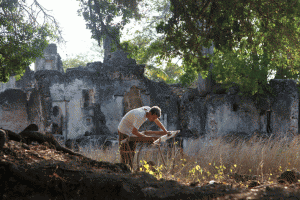While archaeology can be a helpful tool in understanding past cultures and histories, it can also be used in a negative way to reconstruct narratives that justify certain unjust practices. The past is typically seen as indisputable fact, but in reality it is highly contestable. Archaeology aids in constructing a skewed reality of the past by “othering” groups of people defend their discriminatory policies.
For example, British diplomats in the East India Company justified manipulating and demeaning the Hindi religion by explaining that they were simply exploring the culture. At this time, the British Empire was at its height and had immense influence on not only its own country, but the rest of the world. Sanskrit manuscripts, history books, and other parts of their culture were systematically destroyed to create a place for new stories about India that the British had complete control over. This technique is very useful in colonial domination because by erasing the truth and inserting a new reality, it is easier to give grounds for the actions and violence they are committing. By saying that India was a less advanced country that needed the assistance of a great nation like Britain, invading is warranted.
Reconstructing of narratives also occurs today and with recent history. There are many cities in the United States that are characterized as unsafe places ridden with drugs and crime. Biased articles are written and skewed statistics are shared to distort the real image of the city. For example, Brownsville is a neighborhood in Brooklyn that is notorious for high levels of poverty and crime. The only time that it is ever in the news is when people are reporting on the intense level of crime and drug use in the neighborhood. The people of Brownsville are depicted as delinquent criminals who live off well fare and commit horrible felonies. While there are high rates of crime and poverty, these images do not represent the neighborhood and its’ inhabitants as a whole. This is a tactic to scaring people away from the neighborhood and “othering” the residents of Brownsville to further segregate it.
Archaeology has the ability to reveal certain unknown aspects of cultures, but it is extremely important to acknowledge how archaeologists go about this process. It needs to be clear that there are no alternative motives and that they are not using their position of power to harm others. When this is not the case, archaeology and constructing past histories can have horrible impacts for generations.
Photo sources:
https://technoayurveda.wordpress.com/2011/10/14/manuscripts/
Further Interests:
https://www.encyclopediaofauthentichinduism.org/articles/31_organized_efforts.htm




